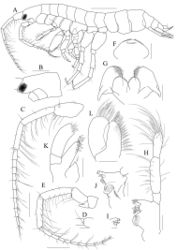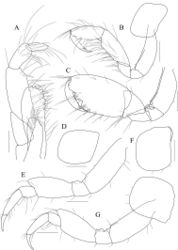Podoceropsis insinuomanus
| Notice: | This page is derived from the original publication listed below, whose author(s) should always be credited. Further contributors may edit and improve the content of this page and, consequently, need to be credited as well (see page history). Any assessment of factual correctness requires a careful review of the original article as well as of subsequent contributions.
If you are uncertain whether your planned contribution is correct or not, we suggest that you use the associated discussion page instead of editing the page directly. This page should be cited as follows (rationale):
Citation formats to copy and paste
BibTeX: @article{Jung2019ZooKeys886, RIS/ Endnote: TY - JOUR Wikipedia/ Citizendium: <ref name="Jung2019ZooKeys886">{{Citation See also the citation download page at the journal. |
Ordo: Amphipoda
Familia: Photidae
Genus: Podoceropsis
Name
Podoceropsis insinuomanus Jung & Coleman & Yoon, 2019 sp. nov. – Wikispecies link – ZooBank link – Pensoft Profile
Etymology
The composite epithet of the specific name, insinuomanus, is a combination of the Latin words insinuo and manus, meaning sinuous hand. This name refers to the strongly sinuated shape of male gnathopod 2 palmar margin.
Material examined
Holotype: ♂ (4.2 mm), NIBRIV0000806531. Gageo-do Island, Jeollanam-do, South Korea (34°02'57"N, 125°08'14"E), 28 Oct 2015, light trap (6.6 m depth), by TW Jung.
Additional material: ♂, 3.3 mm, NIBRIV0000848933. Daryeo-do Island, Bukchon, Jeju-do, South Korea (34°34'56"N, 126°57'17"E), 30 Nov 2012, grab sampler (about 20 m depth), by Prof. HY Soh.
Diagnosis
Gnathopod 2 propodus stout, subovoid, 1.6× as long as basis, palmar margin strongly bisinuate, wrinkly, with subrectangular protrusion near dactylus base and excavated posteriodistally, defined by one robust seta medially. Pereopod 5 basis subovoid, posteriodistal notch really weak.
Description
Holotype male. Head (Fig. 21B) 1.2× as long as pereonites 1–2 combined; lateral cephalic lobe subtriangular, with small tip additionally on apex; eye circular, large, occupying most of lateral cephalic lobe; antennal sinus deep. Antenna 1 (Fig. 21C, D) peduncle 1st article stout, half as long as head, with one robust seta at posteriodistal corner; 2nd article 1.6× as long as 1st article; 3rd article 0.7× as long as 2nd article; accessory flagellum uniarticulated, vestigial; flagellum 0.9× as long as peduncle 1st–3rd articles combined, composed of ten articles (terminal article rudimentary).
Antenna 2 (Fig. 21E) as long as antenna 1; each peduncle’s 4th and 5th articles as long as 2nd article of antenna 1; flagellum 0.9× as long as peduncle 3rd–5th articles combined, composed of ten articles (terminal article rudimentary).
Upper lip (Fig. 21F) convex anteriorly, entire, covered with minute setae.
Lower lip (Fig. 21G) inner lobe subovoid, outer lobe apex rounded, covered with minute setae, with one robust seta at mediodistal corner; mandibular process well developed.
Mandibles (Fig. 21H–J) with 1/2 and 4-dentate incisor, 4-dentate lacinia mobilis, and five raker setae on left mandible; with 5-dentate incisor, minutely dentate lacinia mobilis, and five raker setae on right mandible; molar well developed, triturative; palp asymmetrical, composed of three articles, 3rd article distally rounded, 0.7× as long as 2nd article, with setae extending along most of posteriodistal margin.
Maxilla 1 (Fig. 21K) inner lobe small, produced distally, with one plumose seta; outer lobe with ten dentate robust setae on apical margin; palp biarticulated, distal article curved, not swollen, with five setae on apical margin.
Maxilla 2 (Fig. 21L) inner lobe with an oblique row of plumose setae on surface; outer lobe slightly larger than inner lobe.
Maxilliped (Fig. 22A) inner lobe subrectangular, slightly expanded distally, with three nodular setae apically and one medial nodular seta subdistally; outer lobe exceeding half of palp 2nd article, lined with eight robust setae along apex to medial margin; palp composed of four articles, 3rd article slightly expanded distally, 0.4× as long as 2nd article, 4th article 0.8× as long as 3rd article, with elongate seta apically (as long as 4th article). Gnathopod 1 (Fig. 22B) coxa subrhomboid, 0.8× as wide as long; basis subtrapezoidal, 1.3× as long as coxa, scarcely setose, anterior margin lateral border weakly lobate distally, posterior margin rather convex; carpus elongate, as long as basis, 0.3 as wide as long, slightly widened distally, carpal lobe not developed; propodus 0.7× as long as carpus, rounded anteriorly, palm indistinct, posterior margin minutely serrated on distal half margin; dactylus elongate, 0.9× as long as propodus, with three teeth on inner margin.
Gnathopod 2 (Fig. 22C, D) stout, 1.1× as long as gnathopod 1; coxa subrhomboid, as long as and 0.8× as wide as that of gnathopod 1, rounded anterioventrally; basis scarcely setose, anterior margin both medial and lateral borders forming lobes distally but that of lateral more produced distally; ischium anterior margin with both lateral and medial lobes well developed; carpus with weak carpal lobe posteriorly; propodus stout, subovoid, 1.6× as long as basis, 0.6× as wide as long, anterior margin evenly rounded, posterior margin 0.6× as long as anterior margin, palmar margin oblique, strongly bisinuate, wrinkly, with subrectangular protrusion near dactylus base and excavated posteriodistally, defined by one robust seta medially; dactylus half as long as propodus, slightly exceeding palm, with five teeth on inner margin.
Pereopod 3 (Fig. 22E, F) coxa quadrate, 1.2× as long as that of gnathopod 2, evenly rounded anterioventrally; basis subtrapezoidal, expanded posteriorly, 0.4× as wide as long; merus 0.8× as long as basis, as wide as basis, expanded anteriodistally, produced distal corner reaching half of carpus; carpus almost rectangular, short, 0.3× as long as basis; propodus diminished distally, half as long as basis; dactylus 0.6× as long as propodus.
Pereopod 4 (Fig. 22G) coxa 1.2× as wide as that of pereopod 3; other articles almost similar to those of pereopod 3.
Pereopod 5 (Fig. 23A) coxa bilobed, anterior lobe rounded and expanded ventrally, 0.9× as wide as basis, posterior lobe narrow, extended backwards, with one robust and one simple seta; basis subovoid, broader proximally, 0.7× as wide as long, anterior margin rounded, posterior margin weakly crenulated, lined with simple setae only, with weak distal notch; merus slightly widened distally, half as long as basis, 0.6× as wide as long, not twisted, posterior margin with one elongate robust seta at middle; carpus almost rectangular, slightly plump, 0.7× as long as merus, 0.6× as wide as long; propodus 1.6× as long as carpus, somewhat widened distally, with two robust setae on anterior margin and one pair of unequal locking setae distally (longer seta exceeding dactylus); dactylus falcate. 0.4× as long as propodus. Pereopod 6 (Fig. 23B) 1.4× as long as pereopod 5; coxa bilobed, anterior lobe smaller than that of pereopod 5, with two setae anteriorly, posterior lobe slightly larger than anterior lobe, weakly dilated posterioventrally, with two setae posteriorly; basis subovoid, broader proximally, as wide and 1.3× as long as that of pereopod 5, anterior margin evenly rounded, with two robust setae, posterior margin weakly crenulated, lined with simple setae only, with weak distal notch; merus 0.6× as long as basis, 0.4× as wide as long, posterior margin expanded distally, with elongate robust setae (longest seta 0.3× as long as merus); carpus subrectangular, slightly widened distally, 0.7× as long as merus, 0.4× as wide as long; propodus linear, 1.7× as long as carpus, a little widened distally, with a pair of unequal locking setae; dactylus stout, falcate, half as long as propodus.
Pereopod 7 (Fig. 23C, D) 1.2× as long as pereopod 6; coxa unilobed, dilated posterioventrally; basis subovoid, as wide and 1.1× as long as that of pereopod 6, anterior margin evenly rounded, with one robust seta, posterior margin weakly crenulated, lined with simple setae only, proximal cusp developed proximally, with weak distal notch, medial surface with two plumose setae, merus expanded posteriodistally, 1.2× as long and 0.9× as wide as that of pereopod 6, posterior margin with elongate robust setae (longest seta 0.3× as long as merus); carpus subrectangular, slightly widened distally, 0.7× as long as merus, with a group of robust setae at posteriodistal corner (longest seta 0.6× as long as carpus); propodus as long as basis, slightly widened distally, distal locking setae unequal in length; dactylus stout, 0.4× as long as propodus.
Epimeron 1 rounded, with a notch bearing minute seta on posterioventral corner. Epimera 2 and 3 each posterioventral corner produced backwards, with a notch bearing minute seta (Fig. 23E).
Uropod 1 (Fig. 23F) peduncle with distoventral spine 0.2× as long as peduncle, with four dorsomedial and ten dorsolateral robust setae; inner ramus 0.7× as long as peduncle, with two dorsomedial robust setae and one group of four robust setae on apex; outer ramus 0.8× as long as inner ramus, with two dorsolateral robust setae and one group of four robust setae on apex.
Uropod 2 (Fig. 23G) 0.8× as long as uropod 1; peduncle 0.6× as long as that of uropod 1, both dorsal margins with distal robust seta only; inner ramus 1.1× as long as peduncle, with three dorsomedial robust setae and one dorsolateral robust seta, with one group of four robust setae on apex; outer ramus 0.7× as long as inner ramus, with one dorsomedial robust seta and two dorsolateral robust setae, with one group of four robust setae on apex.
Uropod 3 (Fig. 23H, I) 0.4× as long as uropod 1; peduncle 0.6× as long as that of uropod 2; inner ramus 0.7× as long as peduncle, tapering distally, terminated by one robust seta; outer ramus as long as inner ramus, biarticulated, 2nd article vestigial, with two elongate setae subapically.
Telson (Fig. 23H, I) subtrapezoidal in dorsal view, produced in apex, margins rounded, with a pair of robust setae on each side.
Remarks
Podoceropsis insinuomanus sp. nov. is closely related to Podoceropsis barnardi Kudryashov & Tzvetkova, 1975, reported from the southern and western Sakhalin, eastern Russia (Kudryashov and Tzvetkova 1975[1]) and Vancouver, Canada (Conlan 1983[2]), in the similar shape of the palmar margin of male gnathopod 2. However, this new species differs from P. barnardi in the shape of the posterior margin of male pereopod 5 basis, which has a very weak distal extension (well-developed in P. barnardi), biarticulated uropod 3 with the terminal article being vestigial (uniarticulated in P. barnardi) (Kudryashov and Tzvetkova 1975[1]; Conlan 1983[2]).
Original Description
- Jung, T; Coleman, C; Yoon, S; 2019: Taxonomic study on the photid amphipods (Senticaudata, Corophiida, Photoidea, Photidae) from Korean waters, with descriptions of a new genus and seven new species ZooKeys, 886: 1-59. doi
Images
|
Other References
- ↑ 1.0 1.1 Kudryashov V, Tzvetkova N (1975) New and rare species of Amphipoda (Gammaridea) from the coastal waters of the South Sakhalin.Zoologicheskii zhurnal54: 1306–1315.
- ↑ 2.0 2.1 Conlan K (1983) The amphipod superfamily Corophioidea in the Northeastern Pacific region. 3. Family Isaeidae: Systematics and Distributional Ecology. Publications in Natural Sciences 4: 1–75. (National Museum of Natural Science: Ottawa, Canada.)


